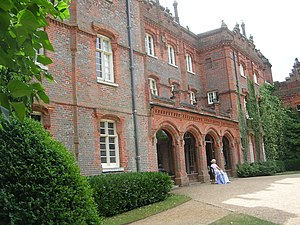Hughenden Manor
| Hughenden Manor | |
|---|---|
National Trust for Places of Historic Interest or Natural Beauty | |
Listed Building – Grade I | |
| Official name | Hughenden Manor |
| Designated | 21 June 1955 |
| Reference no. | 1125785 |
Listed Building – Grade II | |
| Official name | Stable Block and Attached Garden Walls at Hughenden Manor |
| Designated | 4 July 1985 |
| Reference no. | 1332071 |
National Register of Historic Parks and Gardens | |
| Official name | Hughenden Manor Park and Garden |
| Designated | 30 July 1987 |
| Reference no. | 1000318 |
Hughenden Manor, Hughenden, Buckinghamshire, England, is a Victorian mansion, with earlier origins, that served as the country house of the Prime Minister, Benjamin Disraeli, 1st Earl of Beaconsfield. It is now owned by the National Trust and open to the public. It sits on the brow of the hill to the west of the main A4128 road that links Hughenden to High Wycombe.
History
The
After passing through his extended family following a series of deaths and resultant will bequests, by 1816 the manor and lands were owned by John Norris, a distinguished antiquary and scholar.

Lady Beaconsfield died in 1872, and Disraeli in 1881; both were buried in a vault adjacent in the churchyard of St Michael and All Angels Church which is situated downhill from the main house to the east. The church contains a memorial to the Earl erected by Queen Victoria: the only instance of a reigning British monarch ever erecting a memorial to a subject.[citation needed]
Disraeli had no children; he left Hughenden to his nephew, Coningsby Disraeli. However, as Coningsby was only 14 at the time, his trustees rented out the property until he came into his inheritance in 1888. When Coningsby died in 1936, his widow left Hughenden, and the following year Disraeli's niece sold the house to W H Abbey, who vested it, with the remaining contents and 189 acres (0.76 km2), in the Disraelian Society.[4]
During the
In 1947, the Abbey family and the Disraelian Society made Hughenden over to the
The park and woodlands total almost 1,500 acres (6.1 km2). The formal garden which was designed by Lady Beaconsfield (Queen Victoria created Mary Anne a Viscountess in her own right in 1868), has been restored to a similar condition to when occupied by the Disraelis. The long terrace at the rear of the house is decorated with Florentine vases. A monument on a nearby hill, visible from the house, was erected by Mary Anne in 1862 in memory of her father-in-law.[citation needed]
Architecture and description

The present house was built towards the end of the 18th century and was of a stuccoed and unassuming design.
Pevsner clearly failed to appreciate what the delighted Disraeli described as the "romance he had been many years realising" while going to say that he imagined it was now "restored to what it was before the civil war".[9] As the house was not originally constructed until the middle of the 18th century, almost a century after the Civil War, that scenario would have been difficult.[original research?]
The house is of three floors. The reception rooms are all on the ground floor, most with large plate glass windows (a Victorian innovation) giving onto the south-facing terrace overlooking a grassy parterre with views over the Hughenden Valley.[citation needed]
The west wing was built in 1910, long after Disraeli's death, when the house was in the ownership of his nephew, the politician Coningsby Disraeli.[citation needed]
Notes
- ^ a b c d e f "Victorian County History - Buckinghamshire". British History Online. Retrieved 14 December 2020.
- ^ Porter & Prince 2006, p. 243.
- ^ Blake, pp. 250–253.
- ^ a b Garnett 2009, p. ?.
- ^ "Secret base's WWII role revealed". BBC News. 25 April 2005.
- ^ Historic England. "Hughenden Manor (Grade I) (1125785)". National Heritage List for England. Retrieved 9 January 2015.
- ^ Historic England, "Hughenden Manor (1000318)", National Heritage List for England, retrieved 18 December 2016
- ^ a b c Pevsner & Williamson 2003, pp. 405–406.
- ^ a b Garnett 2009, p. 42.
Sources
- Porter, Darwin; Prince, Danforth (2006). Frommer's England. Frommer's. ISBN 0-7645-9540-7.
- OCLC 1138916232.
- OCLC 1204460755.
- Garnett, Oliver (2009) [1997]. Hughenden Manor. The National Trust. ISBN 978-1-84359-173-3.

